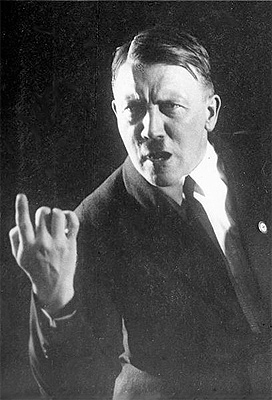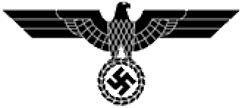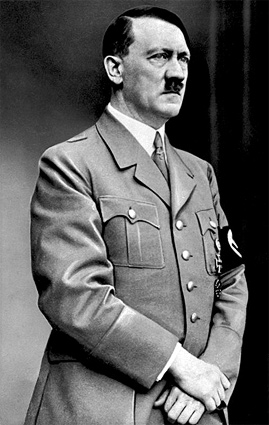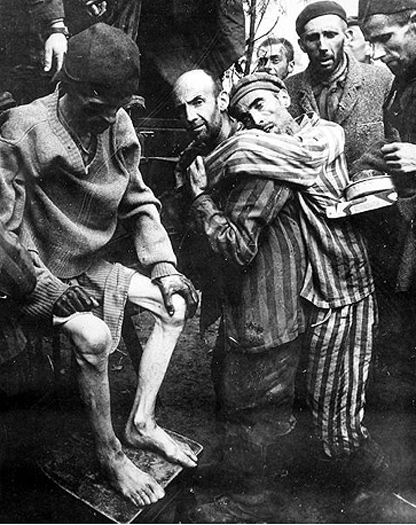
Source: Bundesarchiv Bild 102-13774, Adolf Hitler, Heinrich Hoffmann, Wikimedia

Source: Bundesarchiv Bild 102-13774, Adolf Hitler, Heinrich Hoffmann, Wikimedia
Like Mussolini, Adolf Hitler had served in WW I and returned to find his country in ruins. In 1919, he joined the National Socialist German Workers’ Party (Nazi Party). Despite its name, the Nazi Party has very little to do with Socialism but rather had more militaristic goals. Hitler’s gift for public speaking made him a natural choice for Party Spokesman and later Party Leader. While in prison for a failed attempt to take over the government, Hitler outlined his goals in his book Mein Kampf (My Struggle).
Hitler wanted to unite all German-speaking people, including those in surrounding countries, and pursue national expansion so that the German people would have living space in which to thrive. He also believed that "racial purification" was necessary and that the Aryan (blonde, blue eyed, white, Christian) race was destined to rule over “inferior races”.


Source: Bundesarchiv Bild 183-S33882, Adolf Hitler retouched, Wikimedia
By 1932 the Nazi Party was the strongest political party in Germany. Many of the 6 million unemployed Germans were joining Hitler’s private army known as the “Storm Troopers” or “Brown Shirts.” In 1933, Hitler was elected (that’s right, elected) to the position of Chancellor (Prime Minister) of Germany. This was the last free election held in Germany until after WW II.
In less than 6 months, Hitler had been given ‘temporary’ dictatorial powers that he never relinquished and had dismantled Germany’s Democratic Weimar Republic, replacing it with what he called “The Third Reich" (empire.) He claimed The Third Reich would rule for 1000 years, returning Germany to its former glory and more.

![]() Watch this video about how Hitler came to power.
Watch this video about how Hitler came to power.
Once in power, Hitler began his campaign to make Germany the supreme world power. He had both public elements of his plan and secret ones. The public parts of his plan included unifying all German-speaking people through expansion and conquest. Some nations' populations (like most of Austria's) were in favor of unification with Germany. Others were invaded and conquered such as Czechoslovakia, and Poland. During this time, the rest of Europe harshly admonished Hitler for his militaristic and cruel behavior but did little else to stop him. Most Europeans wanted to avoid a second world war and so were willing to turn a blind eye to such acts of aggression, not realizing that Hitler (as well as Mussolini) believed war was the path to restoring greatness for their countries.
The secret elements of his plan had to do with racial purification in Germany. Hitler began to persecute all people he felt were inferior. This included Jews, Slavs, Gypsies, communists, and eventually Catholics and any other non-Aryan group. Through propaganda, Hitler was able to blame these groups for all the problems Germany was facing. Desperate for hope and change, many Germans willingly went along with Hitler’s campaign, in some cases believing these people were being sent to work camps that would help in the coming war effort. In reality, these “work camps” were really death camps - places to send people that would soon be mass murdered.
Below is a picture of one such camp. These people were tortured and starved to death while waiting to be sent to the gas chamber. Have you ever been persecuted based on your race, faith, or customs?
In your notes, take a moment to journal about how these people must have felt. Or write about why you think the German people allowed this to happen.

Source: Wobbelin Concentration Camp, Department of Defense. Department of the Army. Office of the Chief Signal Officer, National Archives, National Archives